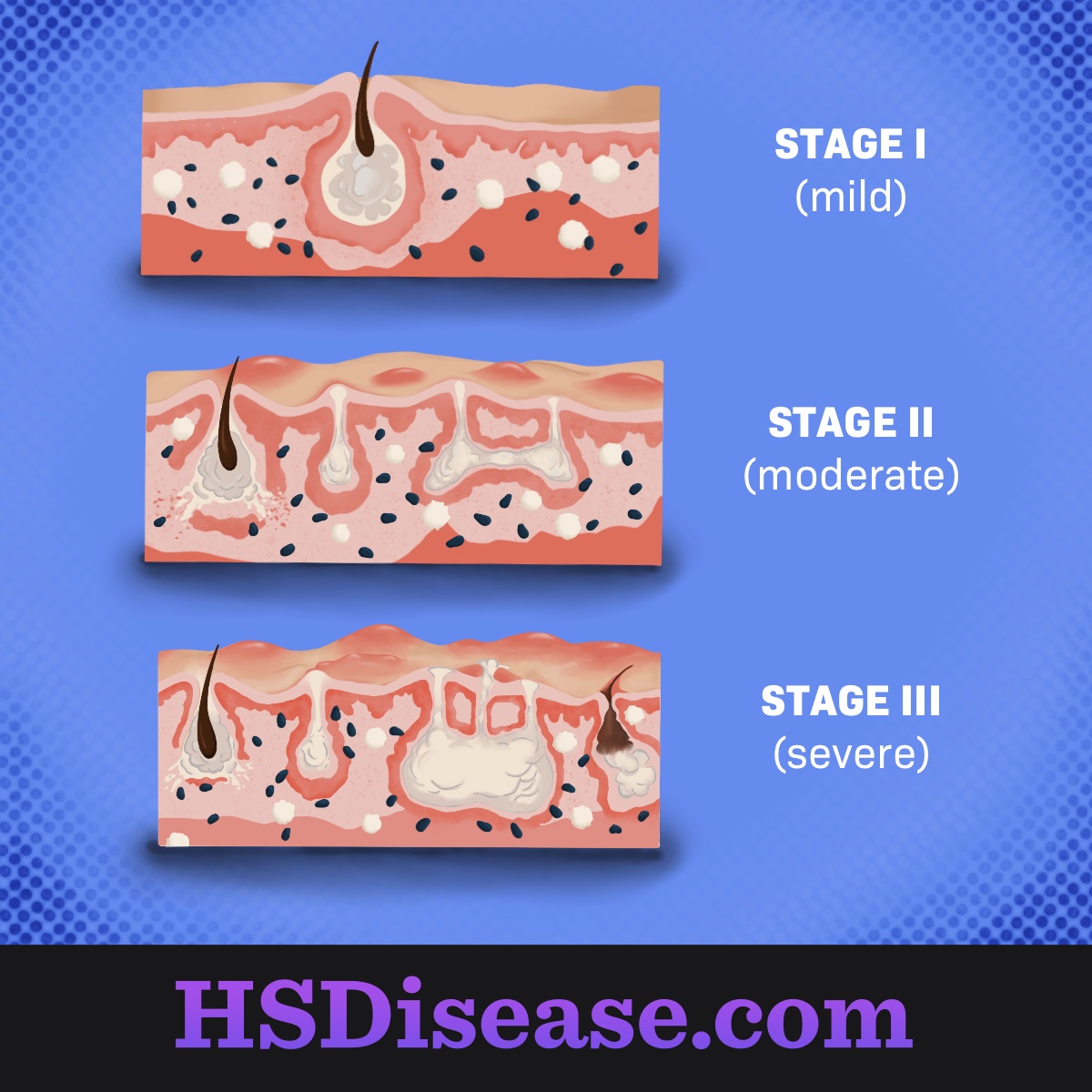Physical Examinations and the Hurley Staging of HS
Reviewed by: HU Medical Review Board | Last reviewed: December 2020 | Last updated: October 2021
Correct diagnosis of your medical condition is important so you can get the right treatment to improve your health. Hidradenitis suppurativa (HS) does not have a test to identify the disease. Instead, you depend on an experienced dermatologist (skin specialist) to recognize the signs and symptoms.
HS is a painful, chronic inflammatory skin disease. The disease begins when clogged hair follicles cause bumps or lesions (sores). The process leads to:1
- Abscesses
- Pus
- Odor
- Inflammation
- Tunnels under the skin
- Scars
Flares worsen pain and discharge of pus. Generally, flares last about a week to 10 days.2
Key elements in HS physical examination
A dermatologist diagnoses HS by looking for a number of important signs and symptoms during a physical examination.
Lesion types
- Comedones – bumps that result when skin cells, bacteria, and oil block hair follicles. When open at the surface of the skin, comedones are blackheads. Closed comedones are whiteheads.3,5
- Papules – solid bumps up to 1 centimeter (less than half an inch) wide.3,5
- Pustules – bumps that contain pus.3,5
- Abscesses – painful, swollen lumps filled with bad-smelling pus. Burst hair follicles cause deep abscesses in the dermis, the thickest layer of skin. As pus spills out, it causes more inflammation.3,5
- Sinus tracts – narrow tunnels under the skin, sometimes connecting the lesions. Repeated clogging and bursting of hair follicles lead to formation of sinus tracts that drain pus.3,5
Location of lesions
The locations of HS lesions, from the most common to the least common, include:3,6-8
- Armpit
- Groin (the folds where the abdomen joins the legs)
- Area around the anus and between the anus and genitals
- Breasts and below the breasts
- Buttocks
- Pubic area
- Chest
- Scalp
- Behind the ears
- On the eyelids
People who have HS lesions around the anus and genitals may also have them in the anal canal. Other less common HS lesion locations include:3,6-8
- The nape of the neck
- Inner thighs
- Scrotum
- Vulva
- Abdomen near the belly button
- Around the waist
Symmetry of lesions
HS lesions are usually symmetrical, or balanced. If an area on one side of the body is affected, the corresponding area on the opposite side is affected too.8
Recurrence of lesions
HS lesions recur or return again and again. They are likely to return even after medical or surgical treatment.6
Severity assessment
A number of tools have been developed to assess the severity of HS. These tools help doctors determine the right treatments for people living with the condition.
Hurley staging system
The Hurley staging system is the simplest and most widely used by doctors who treat people with HS. It was introduced in 1989. The Hurley system is not quantitative, which means doctors use it to observe symptoms but not measure them. For that reason, it is not used for monitoring response to treatments in clinical trials.3,9,10
Figure 1. HS Hurley staging
The Hurley staging system classifies HS into 3 stages:3,9,10
- One or more lesions or abscesses, without sinus tracts and scarring
- Recurrent abscesses with limited amount of widely separated lesions, sinus tracts, and scarring
- Multiple or extensive interconnected sinus tracts, abscesses, and scarring
Modified Sartorius Score (MSS)
This system is based on measuring numbers of lesions and distances between them. It gives doctors lots of details, but it is time-consuming and sometimes hard to interpret.3
HS-Physician’s Global Assessment (PGA)
The tool describes six stages of disease severity based on the number of HS lesions, with stages ranging from clear to very severe. It is relatively easy to use for measuring improvement in clinical trials of medical treatments. However, it does not include ratings from the person with HS.3
HS Severity Index (HSSI)
This system scores severity in several categories, such as the number of lesions and pain. It also has the person living with HS rate their disease severity.3
Inflammatory lesion counts
The total number of abscesses and inflammatory bumps are counted and used to calculate response to medical treatment. Called Hidradenitis Suppurativa Clinical Response (HiSCR), the tool is only used in clinical trials to measure reductions in disease severity.9
Biopsy or culture
Biopsies and bacterial cultures of pus are used only when a person has atypical HS or a case that does not respond to treatment. In most cases, the cultures of HS do not find bacteria. Other times, they may help diagnose a secondary infection.2
Once your HS diagnosis is clear, your doctor can begin treatment to relieve your pain and prevent more severe disease.
